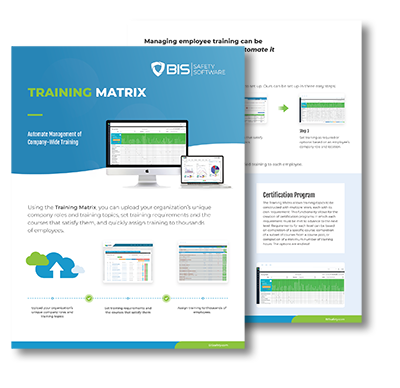
Complacency is a longstanding issue in the workplace, often manifesting as a lack of awareness or a disconnect from the tasks at hand. It typically arises when individuals make assumptions based on their past experiences. For instance, someone might assume a grinding wheel won’t break simply because it never has, or believe a pathway is always clear because it usually is.
Motivation, incentives, and boredom are key factors that contribute to complacency and need to be addressed thoughtfully. While OSHA frequently links complacency to numerous accidents, there isn’t specific data tracking complacency itself. Despite the challenge in measuring it directly, complacency remains a critical issue that shouldn’t be overlooked.

Things to Consider Before Addressing Complacency
Effectively tackling complacency requires empathy and an understanding of the employees’ perspectives. Context is crucial, and without it, finding effective solutions becomes much harder. Alongside a thoughtful approach, it’s essential to understand the risks and data associated with complacency. We’ve outlined key areas to help leaders develop tailored strategies for each task:
Recognizing Complacency: Identifying signs of complacency in the workplace.
Universal Contributors to Complacency: Common factors that lead to complacent behavior.
Personal Contributors to Complacency: Individual-specific factors that contribute to complacency.
Statistics: Data and trends related to workplace complacency.
Battling Complacency: Strategies to combat complacency effectively.
Impact on Society and Individuals: How complacency affects both society and individuals.
Cost of Complacency to Businesses: Financial implications of complacency for businesses.
Reinvigorating Your Staff: Techniques to motivate and re-engage employees.
Cure for Complacency: Long-term solutions to prevent complacency.
Download the Complacency Guide!
Combatting Complacency Guide: A FREE Resource
You can help reduce complacency-related incidents at your company with our comprehensive guide, which includes:
Over 24 pages of insights
Coverage of various scenarios, including falls and driving
Analysis of the costs of complacency
Practical advice on combatting complacency

Quick Tips to Reduce Complacency in the Workplace
Complacency at work can slow things down, cause accidents, and lower team spirit. Here are some easy-to-follow tips to help keep your workplace active and alert:
Regular Training Refreshers
Keep your team sharp by offering regular training sessions. This helps everyone stay updated and remember the best ways to do their jobs.
Encourage Open Communication
Make sure your team feels comfortable sharing their thoughts and concerns. Regular feedback helps catch small issues before they become big problems.
Set Clear Goals
Everyone should know what’s expected of them. Clear goals and regular check-ins can keep your team focused and motivated.
Rotate Tasks
Mix things up by rotating tasks and responsibilities. This keeps work interesting and helps your team develop new skills.
Recognize and Reward Efforts
Show appreciation for hard work. Recognizing and rewarding employees can motivate everyone to do their best.
Promote Safety
Make safety a top priority with regular drills and clear protocols. Encourage your team to report any safety concerns.
Lead by Example
As a leader, your behavior sets the tone. Show your commitment to high standards, and your team will follow.
Conduct Regular Audits
Regular checks can catch potential problems early. Use audits as a chance to improve, not to punish.
Encourage Teamwork
Promote a collaborative environment. Team projects and problem-solving can keep everyone engaged and accountable.
Offer Growth Opportunities
Provide chances for career advancement and skill development. When employees see a future with the company, they stay motivated.
Use Technology Wisely
Use technology to make work easier but ensure it enhances rather than replaces critical thinking. Keep your tools up-to-date.
Maintain a Positive Environment
Create a supportive and respectful workplace. Address conflicts quickly and make sure everyone feels valued.
Conduct Performance Reviews
Regular reviews help set clear expectations and provide valuable feedback, pushing employees to keep improving.
Encourage Innovation
Invite employees to share new ideas. An environment that values creativity keeps everyone engaged.
Provide the Right Tools
Ensure your team has what they need to do their jobs well. Having the right resources helps everyone take pride in their work.

Conclusion
Maintaining a safe work environment is a collective responsibility, whether at work or home. A false sense of security can lead to significant risks. It’s crucial to conduct regular training and educational exercises to improve focus, enhance awareness, and foster a supportive environment.
As a society, we must continue to collect, analyze, and share data to manage risks effectively. These analyses help us gauge the effectiveness of our safety measures and identify areas for improvement. Using statistics as a guide, we can pinpoint where enhancements are needed.
Investing in ourselves to remain conscious of minimizing injury is vital. By creating a structure that supports safety in all aspects of our lives, we can significantly reduce risks. Stay eager to learn, maintain sharp attention, and never overlook the details.
Creating a safe workplace culture involves choosing leaders who can inspire and guide your staff. It requires consistent corrections and observations. A proactive approach to safety, rather than a reactionary one, will not only reduce accidents but also foster an environment that employees value. Remember, only you can combat complacency.
Related Articles
- All Posts
- 360 Immersive
- 360immersive
- accident prevention
- Alberta safety courses
- Allan James Moore
- asking for help
- avoidable injuries
- awareness
- back strain
- BambooHR integration
- biometric sensors
- BIS Podcast
- BIS Safety Software
- black holes
- Brave Leadership
- burnout
- Canadian safety history
- carbon monoxide
- CCOHS
- chemical
- chemical vapors
- chronic injuries
- chronic pain
- Coming Soon
- community safety programs
- Compliance
- compliance courses
- compliance tools
- compliance vs protection
- Construction advocacy
- Construction education
- Construction industry
- construction safety training
- continuous safety improvement
- crane
- customized training
- daily trip inspection
- Danny Sellers
- data-driven safety
- digital forms
- Dr. Joanna Pagonis
- driver file management
- driver training
- early intervention
- EHS
- Einstein
- electrical safety
- emergency preparedness
- emergency response
- emergency supplies
- emotional training
- employee health
- employee safety
- employee training
- ergonomic risks
- ergonomics
- evidence collection
- exoskeletons
- fall protection
- field safety
- field safety services
- fire prevention
- first aid kit
- first week on the job
- first workplace injury
- fleet management
- frontline safety
- gravitational waves
- hand injuries
- hands-on training
- hazard communication
- hazard prevention
- hazard recognition
- Health & Safety Podcast
- hearing loss prevention
- heavy equipment safety
- hidden workplace hazards
- high voltage systems
- HR automation
- HR software
- human-centered safety
- humor in safety
- immersive learning
- Imposter Syndrome
- incident data
- incident investigation
- incident reporting
- industrial safety
- injury consequences
- injury prevention
- injury prevention tips
- injury recovery
- injury reporting
- injury response
- injury response plan
- internal audits
- invisible dangers
- Jennifer Lastra
- job site hazards
- job site risks
- job site safety
- Jody Young
- KBR Safety Training
- labor movement
- ladder safety
- Leadership
- leadership accountability
- leadership and empathy
- learning from incidents
- lifting techniques
- LIGO
- LMS
- lockout tagout
- lone workers
- mental health at work
- MI Safety
- minor injuries
- new workers
- no-blame investigations
- noise exposure
- Northern BC
- NRCA
- NSC Standard 13
- occupational fatigue
- occupational hazards
- occupational health
- occupational safety
- OHSA
- oil and gas safety
- onboarding safety
- Online safety training
- organizational safety
- OSHA compliance
- OSHA standards
- overhead crane courses
- pain awareness
- personal protective equipment
- physics careers
- pipeline safety
- podcast
- post-accident review
- post-incident protocol
- PPE
- PPE enforcement
- PPE improvement
- pre-trip inspection
- pretrip inspection
- proactive safety measures.
- Professional development
- psychological hazards
- psychological safety
- repetitive motion injuries
- respirator safety
- risk management
- risk reduction
- road safety
- Robin Postnikoff
- root cause analysis
- routine task risks
- safe work habits
- safety
- safety accountability
- safety advice
- safety article
- safety awareness
- safety best practices
- safety communication
- safety compliance
- Safety Conversations
- safety culture
- safety engagement
- safety follow-up
- safety gear
- safety habits
- safety innovation
- safety insights
- safety inspection
- Safety Leaders
- safety leadership
- safety legislation
- safety lessons
- safety management
- safety management system
- safety metrics
- safety motivation.
- safety myths
- safety podcast
- safety procedure updates
- safety review process
- safety shortcuts
- Safety Spotlight
- safety systems
- safety technology
- safety theater
- safety tips
- safety training
- safety transparency
- silent dangers
- silica dust
- Sinogap Solutions
- slow-building hazards
- smart helmets
- space science
- supervisor training
- team communication
- teamwork
- Total Recordable Injury Formula
- tough guy mentality
- toxic air
- training
- training courses
- training matrix
- training record management
- transportation
- Trust and Accountability
- unseen workplace threats
- vehicle safety
- veteran advice
- Virtual Reality
- VR safety training
- VR Technology
- wearable technology
- WHMIS
- witness statements
- women in leadership
- work-alone training
- work-related injuries
- worker accountability
- worker advocacy
- worker fatigue
- worker protection
- worker safety
- worker safety habits
- worker trust
- workers' rights
- workforce management
- workforce training
- workplace accidents
- workplace air quality
- workplace best practices
- workplace certification
- Workplace Culture
- workplace hazards
- workplace health
- workplace incident response
- workplace injuries
- workplace injury prevention
- workplace mindset
- workplace risk factors
- workplace risk management
- Workplace safety
- workplace safety culture
- workplace safety rules
- workplace safety tips
- workplace safety training
- workplace stress
- workplace tiredness
- workplace wellness
- WSPS

Workplace safety cultures fall into three categories: the good, the bad, and the ugly. Some organizations set the gold standard...

Too many workers risk injury by refusing help to appear tough. This article explains how asking for help and supporting...

Canada’s safety standards weren’t handed down—they were hard-won. This article explores the rise of workplace safety from the early industrial...

























